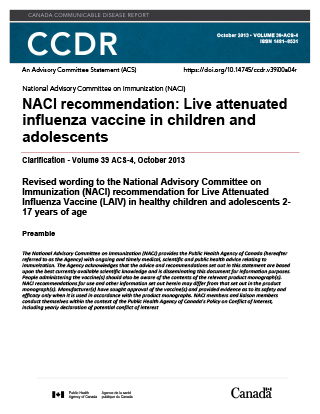NACI recommendation: Live attenuated influenza vaccine in children and adolescents


Download this article as a PDF (106 KB - 2 pages)
Published by: The Public Health Agency of Canada
Issue: Volume 39 ACS-4
Date published: October 2013
ISSN: 1481-8531
Submit a manuscript
About CCDR
Browse
Volume 39 ACS-4, October 2013
Clarification
Revised wording to the National Advisory Committee on Immunization (NACI) recommendation for Live Attenuated Influenza Vaccine (LAIV) in healthy children and adolescents 2-17 years of age
DOI
https://doi.org/10.14745/ccdr.v39i00a04r
Preamble
The National Advisory Committee on Immunization (NACI) provides the Public Health Agency of Canada (hereafter referred to as the Agency) with ongoing and timely medical, scientific and public health advice relating to immunization. The Agency acknowledges that the advice and recommendations set out in this statement are based upon the best currently available scientific knowledge and is disseminating this document for information purposes. People administering the vaccine(s) should also be aware of the contents of the relevant product monograph(s). NACI recommendations for use and other information set out herein may differ from that set out in the product monograph(s). Manufacturer(s) have sought approval of the vaccine(s) and provided evidence as to its safety and efficacy only when it is used in accordance with the product monographs. NACI members and liaison members conduct themselves within the context of the Public Health Agency of Canada's Policy on Conflict of Interest, including yearly declaration of potential conflict of interest.
Live attenuated influenza vaccine use for healthy children and adolescents 2 to 17 years of age
With respect to the live attenuated influenza vaccine, NACI recommends its use for healthy children and adolescents 2 to 17 years of age without contraindications.
There is evidence for the preferential use of LAIV in young children (younger than 6 years of age) based on superior efficacy of LAIV compared to TIV (Grade A), with weaker evidence of superior efficacy in older children (Grade I).
It is anticipated that the superior efficacy for LAIV over TIV extends beyond age 6 years, but the evidence does not indicate at which specific age the efficacies of LAIV and TIV become equivalent.
If LAIV is not available for those for whom it is considered superior, TIV should be used.
Two studies have directly compared the efficacy of LAIV and TIV in younger children (up to age 5 and 6) and one study has compared the efficacy of LAIV in asthmatic children 6 to 17 years of ageFootnote 1Footnote 2. NACI recognizes that there are differences in levels of evidence for younger and older children. There is more evidence that directly compares TIV and LAIV efficacy and that shows superior efficacy of LAIV in children younger than 6 years of age than in older children. Also, for children under 6 years of age the evidence for the superiority of LAIV is of higher quality and the estimate of efficacy is higher compared to the study performed on children 6 to 17 years old.
The study by Fleming et al. (2006) looking at 2229 asthmatic children 6-17 years of age (mean age 11) showed superior efficacy of LAIV over TIV in this age group. These results seem to have been mostly driven by influenza B and were not significant for the H3N2 strain. Although the study has limitations, such as the fact that the study population was asthmatic and so may not be generalizable to all children, its strengths include a randomized design and culture confirmed outcome.
It is hypothesized that as children get older, they are more likely to have had a previous influenza infection, which might interfere with the immune response elicited to LAIV. It is not known at what age LAIV efficacy is no longer superior to TIV in children. In adults, comparative efficacy trials of LAIV and TIV have shown either no difference or superior efficacy of TIV. More evidence is needed that directly compares the efficacy and effectiveness of LAIV and TIV, especially in children over 6 years old and NACI considers this a research priorityFootnote 3.
NACI also acknowledges that LAIV offers other advantages to children, including needle-free administration. As well, as a live, replicating whole virus formulation administrated intranasally, it elicits mucosal immunity which may more closely mimic natural infection and contribute to the superior efficacy compared to TIV.
For more detailed information on NACI recommendations for live attenuated and other influenza vaccines consult the NACI 2013-2014 Seasonal Influenza Vaccine Statement.
Page details
- Date modified: